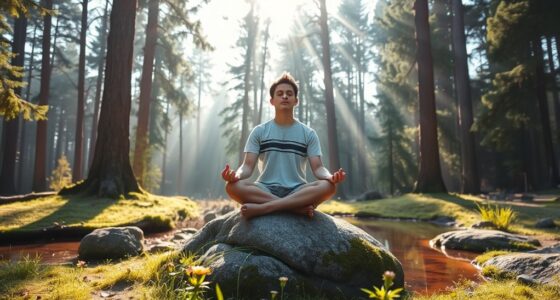Creative expression is a powerful tool for self-discovery, helping you explore your inner thoughts, emotions, and identity. By engaging in activities like painting, writing, or music, you create a safe space to process feelings, uncover hidden patterns, and gain new perspectives about yourself. This ongoing process fosters honesty, vulnerability, and acceptance, deepening your connection with your true self. Keep exploring, and you’ll discover even more ways to unleash your authentic self.
Key Takeaways
- Creative activities provide a safe space for exploring emotions, thoughts, and identity, fostering self-awareness.
- Artistic expression reveals hidden patterns and triggers, offering insights into core beliefs and personal values.
- Engaging in art promotes mindfulness and emotional healing by confronting difficult feelings with honesty.
- Consistent creative practice deepens self-understanding, confidence, and acceptance beyond societal labels.
- Techniques like color calibration enhance self-exploration, guiding individuals toward authentic self-awareness and purpose.

Creative expression offers a powerful pathway to self-discovery, allowing you to explore your inner thoughts, emotions, and identity in a tangible way. When you engage in artistic activities like painting, writing, or playing music, you create a safe space to process feelings that might be difficult to articulate verbally. This process of emotional healing becomes more accessible as you channel your experiences into a medium that feels natural and personal. Through this act of creation, you may find relief from stress, anxiety, or unresolved trauma, making space for clarity and peace. As you pour your emotions onto a canvas or into a song, you begin to understand yourself better, uncovering patterns, triggers, and desires that may have been hidden beneath the surface. This insight becomes a foundation for deeper identity exploration, helping you define who you are beyond societal labels or external expectations.
As you continue to explore through creative outlets, you start noticing recurring themes or symbols that reflect your core beliefs and values. These revelations can be transformative, guiding you toward a more authentic sense of self. You might discover that certain colors, images, or words resonate with your true feelings, leading you to new perspectives about your life and choices. Creative expression acts as a mirror, showing you aspects of yourself you might not have recognized before. It’s a process of peeling back layers, revealing your raw, unfiltered identity. This exploration isn’t about perfection but about honesty—allowing yourself to be vulnerable and genuine. Over time, you build a stronger connection with your inner self, fostering confidence and self-acceptance.
Moreover, engaging in creative activities regularly can serve as a form of mindfulness, helping you stay present with your emotions and thoughts without judgment. This ongoing practice deepens your emotional healing journey, enabling you to confront difficult feelings with compassion and patience. The act of creating becomes a dialogue with yourself, revealing what matters most and helping you prioritize your emotional well-being. As your understanding of yourself grows, so does your resilience, empowering you to face life’s challenges with a clearer sense of purpose. Ultimately, this process of self-discovery through creative expression offers more than just insight; it nurtures a profound relationship with your true self, guiding you toward a more fulfilled, authentic life. Incorporating techniques like color calibration can further enhance the accuracy of your visual self-exploration.
Frequently Asked Questions
How Can Creative Expression Help Improve Mental Health?
Creative expression helps improve your mental health by fostering emotional healing and increasing self-awareness. When you engage in activities like painting, writing, or music, you process complex emotions, reducing stress and anxiety. It allows you to explore your inner thoughts, identify patterns, and gain clarity. This active participation promotes a sense of accomplishment and control, ultimately boosting your overall well-being and resilience against mental health challenges.
What Are Some Creative Activities Suitable for Beginners?
You can start with simple activities like color mixing, which helps you explore hues and develop your sense of color. Sketching basics, such as drawing simple shapes and lines, are great for beginners to build confidence and improve hand-eye coordination. These activities are accessible, fun, and low-pressure, allowing you to express yourself creatively while gradually developing your skills. Just pick up some supplies and start creating!
How Do I Find My Unique Artistic Voice?
To find your unique artistic voice, explore different styles and techniques that resonate with you. Pay attention to your personal style and let it evolve naturally through consistent practice. Seek inspiration from various sources like nature, music, or everyday life to fuel your creativity. Reflect on what feels authentic, and don’t be afraid to experiment. Over time, your distinctive voice will emerge as you stay true to your inner artistic inspiration.
Can Creative Pursuits Replace Traditional Therapy?
Like Da Vinci’s notebooks, your creative pursuits can serve as a form of art therapy and expressive arts, but they shouldn’t fully replace traditional therapy. While art can help process emotions and foster self-discovery, it often lacks the clinical guidance and structured support that professional therapy offers. Use creative expression as a complementary tool, not a substitute, ensuring you get the balanced care you need for mental health.
How to Overcome Fear of Judgment in Art?
To overcome your fear of judgment in art, embrace artistic vulnerability by sharing your work in safe spaces. Practice self-acceptance strategies, like reminding yourself that everyone starts imperfect and growth matters more than perfection. Focus on your personal journey rather than external opinions, and gradually build confidence by exposing yourself to feedback in low-pressure settings. Remember, vulnerability fosters authentic self-expression and deepens your connection with your art.
Conclusion
As you continue to explore your creative side, remember that each stroke, note, or word is a mirror reflecting your true self. Like a river carving its path through the landscape, your creative journey shapes and reveals who you are beneath the surface. Embrace this ongoing process, for in every act of expression, you open a deeper understanding—one that’s always waiting just beneath the surface, ready to be discovered anew.
Felicity, our Author, pens in-depth articles and guides that delve into the heart of personal discovery. Her narrative-driven approach weaves together theory, practice, and personal anecdotes, making the journey of self-exploration both relatable and inspiring. Felicity’s contributions help illuminate the path for those seeking a deeper understanding of themselves and their relationships.










